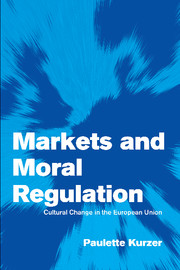Book contents
- Frontmatter
- Contents
- List of tables
- Preface
- 1 Markets versus morality
- 2 Binge drinking: the evolution of alcohol control policy in Finland
- 3 Our greatest social problem: anti-alcohol policy in Sweden
- 4 Nordic morality meets the European Union
- 5 Permissive pragmatism: drug control policy in the Netherlands
- 6 Harm reduction meets the EU: from public health to public order
- 7 Irish moral conservatism and European sexual permissiveness
- 8 The emergence of a European morality?
- Bibliography
- Index
7 - Irish moral conservatism and European sexual permissiveness
Published online by Cambridge University Press: 16 October 2009
- Frontmatter
- Contents
- List of tables
- Preface
- 1 Markets versus morality
- 2 Binge drinking: the evolution of alcohol control policy in Finland
- 3 Our greatest social problem: anti-alcohol policy in Sweden
- 4 Nordic morality meets the European Union
- 5 Permissive pragmatism: drug control policy in the Netherlands
- 6 Harm reduction meets the EU: from public health to public order
- 7 Irish moral conservatism and European sexual permissiveness
- 8 The emergence of a European morality?
- Bibliography
- Index
Summary
The Irish not only are Catholic in name, belonging to an imaginary religious community, but are also devout practitioners. In 1990, 82 percent of Irish Catholics attended weekly Mass, the highest proportion of any population in the world. The Irish became and remained more Catholic than most other Catholic Europeans if measured by devotion, church attendance, and conviction. The “Irish Devotional Resolution” reflected the loss of language and cultural identity during the nineteenth century and was nourished by the growing resistance to Anglicization. Not until the 1850s, however, did institutional Catholicism plant itself firmly in the Irish mentality. The Great Famine (1845–49) destroyed the livelihood of a rural underclass, whose main religious practices included magic. The famine, which killed nearly one million people and forced another million to seek their fortunes overseas, led to the disappearance of this vast rural underclass and introduced new ideas about land ownership and inheritance rights. The Catholic elite and tenant farmers encouraged the adoption of new rules on ownership with a view to modernizing Ireland and from then on priests, brothers, and nuns became important fixtures in the average Irish household. After the famine disaster, the modernizing state handed over the task of civilizing the Irish population to the Church, which assumed responsibility for fostering discipline, education, and civility. By the time that the Irish Free State was founded in 1922, Catholic ethics were internalized in the minds and hearts of the Irish to the extent that they viewed no conflict between individual autonomy and definition of the good life and that of the Church.
- Type
- Chapter
- Information
- Markets and Moral RegulationCultural Change in the European Union, pp. 143 - 169Publisher: Cambridge University PressPrint publication year: 2001



